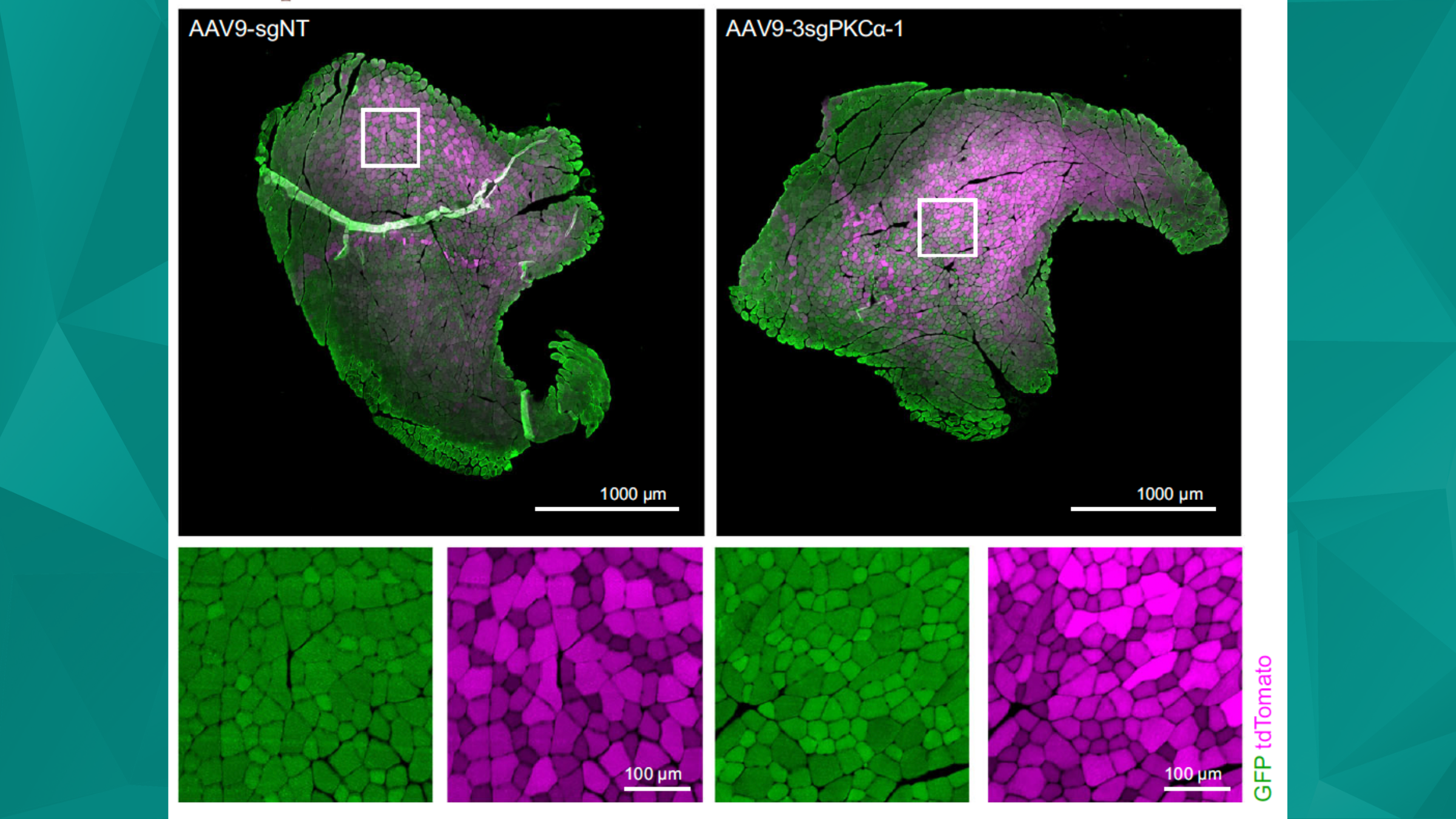
2023 has proved to be a particularly fruitful year for scientific discovery, with a multitude of pioneering studies spanning continents and disciplines. From the intricate workings of muscle physiology in Switzerland to the nuanced understanding of migraine mechanisms in the USA, the discernment of mosquito olfactory processing in India, and the innovative strides in sustainable materials science in Germany and Austria, this year’s research highlights embody the spirit of global collaboration and scientific ingenuity. We hope that, by highlighting the multitude of ways our instruments provide precise and reliable data, future and current researchers can draw inspiration for new and innovative ways to collaborate across borders.
Featured image (©Thürkauf et al. (2023), licensed under CC BY 4.0 Deed), cross section of tibialis anterior (TA) muscle stained for Cas9/GFP (green), tdTomato (magenta), and DAPI (blue), 6 weeks after injection of neuraminidase plus AAV9-sgNT or AAV9-3sgPKCα-1.
Muscle Physiology: A Leap in Gene Editing Techniques (Switzerland)
In one of the first studies we highlighted this year, Thürkauf et al. (2023) in Switzerland reported novel results using a combination of muscle physiology and genetic engineering. By developing a highly effective method for somatic gene deletions in skeletal muscle, they have opened new doors to understanding muscle function in a variety of disease states. Using the 1200A Isolated Muscle System for Mice, they measured force and fatigue in distinct muscle types, offering invaluable insights into muscle dynamics post-gene deletion. This approach not only signifies a major breakthrough in muscle biology but also showcases the seamless integration of advanced genetic techniques with precision instrumentation, setting a new standard in muscular disease research and therapy.
Nociception and Migraine Pathophysiology (USA)
In the United States, the work of Zhao et al. (2023) has further illustrated the complex pathways involved in migraine pathophysiology. Their focus on meningeal P2X7 signaling in migraine pain revealed its key role in the etiology of this condition. The use of the 300B Dual Mode Lever allowed for an unprecedented exploration of mechanosensitivity in meningeal afferents. These new findings have advanced understanding of migraine mechanisms and paved the way for novel therapeutic approaches, potentially offering relief to millions suffering from this debilitating condition. The study is a prime example of how precision technology can unravel the intricacies of human nociception and neurological disorders.
Olfactory Processing in Mosquitoes (India)
Although not a widely used model, a new study on mosquito olfactory processing published by Singh et al. (2023) in India has a wide range of potential applications. Using the 200B miniPID to investigate the neurobiological response of mosquitos to various odor stimuli, the authors were able to accurately monitor odor concentrations, a critical factor in understanding mosquito behavior and neural response. This research not only contributes to the basic understanding of mosquito neurobiology but also has implications for controlling mosquito-borne diseases, showcasing the potential for targeted public health interventions. The approach used in this study highlights the synergy between innovative biological research and sophisticated instrumentation in addressing global health challenges.
Materials Science and Sustainability (Germany/Austria)
The collaborative effort by Rumley et al. (2023) in Germany and Austria marks a milestone in the field of materials science and robotics. Their development of biodegradable electrohydraulic actuators addresses a critical need for sustainability in the burgeoning field of soft robotics. Utilizing the 310C-LR Dual-Mode Lever System, they were able to demonstrate the viability and robustness of eco-friendly materials. This research not only underscores the importance of sustainable practices in technological innovation but also exemplifies the role of advanced scientific instruments in enabling the creation of environmentally responsible technologies.
Conclusions
In summary, 2023 has been a year marked by significant scientific progress across various fields. The innovative research conducted in muscle physiology, migraine pathophysiology, mosquito olfactory processing, and sustainable materials science, facilitated by Aurora Scientific’s instruments, highlights the importance of advanced technology in scientific discovery. These studies, bridging disciplines and countries, exemplify the collaborative nature of modern research and its potential to address complex challenges. As we move forward, the achievements of this year provide a strong foundation for future explorations, encouraging continued innovation and cross-border collaboration in the scientific community.



